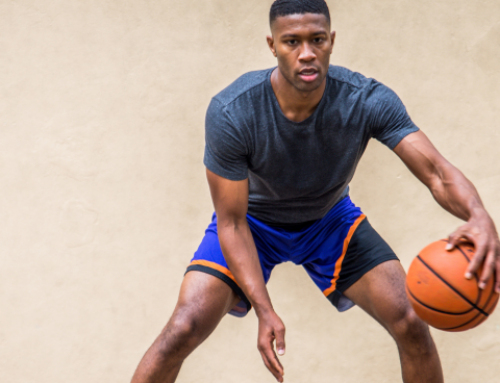Luka’s Secret Superpower: The Overlooked Athletic Trait That Makes Him So Good
A little over 90 games into his NBA career, Luka Doncic has soared past even the most outlandish expectations for him.
After winning the Rookie of the Year award last season, the 20-year-old Slovenian phenom is a legitimate MVP candidate.
As a small forward for the Dallas Mavericks, Doncic is averaging 30.6 points, 9.9 rebounds, 9.6 assists and 1.5 steals per game while shooting 48.3% from the field.
Yet a perceived lack of athleticism was one of the most frequent critiques of Luka during the pre-draft process.
NBADraft.net deemed him an “average athlete by NBA standards” and wrote that “his first step is slow even for European standards.”
And in some sense, that’s true. Doncic’s speed is not blinding. His leaping skills aren’t awe-inspiring. His sheer strength is not overwhelming.
But Doncic is certifiably elite when it comes to a more unconventional measurable of athleticism—deceleration.
While acceleration is about how fast you can speed up, deceleration is about how quickly you can slow down. For athletes whose roles require frequent changes in direction and speed—such as a football wide receiver or a basketball ball-handler—the ability to cut on a dime or quickly alter velocity is highly valuable.
“Luka possesses an elite ability to go from 60 to 0, something you might use during a step-back or a crossover,” Eric Leidersdorf, Director of Biomechanics at P3 Applied Sports Science, explains in this video. “Luka possesses the ability to create a significant amount of force during the eccentric or deceleration phase of a counter-movement jump. This is a quality integral to change of direction performance.”
Doncic has been visiting P3, a high-tech training facility in Santa Barbara, California, at least once a year since he was 15 years old. P3 has amassed a huge amount of data on NBA players, as they’d evaluated 58% of the players who were on this season’s opening-night rosters.
Last November, they shared this graphic highlighting how Doncic’s eccentric force output and eccentric rate of force development—two key metrics of deceleration—compared to James Harden, another player who baffles defenses with his ability to quickly slam on the brakes:
While Harden ranks in the 99th percentile of P3’s NBA database for both eccentric force output and eccentric rate of force development, Doncic isn’t far behind, ranking in the 92nd and 93rd percentiles, respectively.
“Luka’s one of these guys that his most glaring performance advantages, his superpowers, are not the things that have traditionally defined athleticism in a basketball player,” Marcus Elliot, founder and director of P3, told The Athletic. “(That fact) makes him the perfect athlete for teams to get confused with (and) make bad decisions about his athleticism.”
Luka’s elite deceleration and change of direction skills are key to his signature move—the step-back jumper.
One reason the move’s so deadly is because Luka is able to cover an enormous amount of ground as he pushes off his plant foot. So much so, that it occasionally looks like he’s about to break into the splits.
According to P3, Doncic’s hip abduction during a 1-Off Skater Test (which is similar to the movement required during a step back) ranks in the 85th percentile of their NBA database. “Abduction is essentially the angle created by moving the drive-leg away from (the) mid-line of body,” P3 wrote in a tweet.
When they decide to stop on a dime, many athletes’ upper half will continue to fall forward after they’ve planted their foot in the ground, so much so that it negatively impacts their balance and they must take time to reset themselves before efficiently executing subsequent athletic actions.
The 6-foot-7, 218-pound Doncic is exceptionally good at controlling his hips and trunk during deceleration, meaning he remains balanced and in control as he slows down.
“He’s got a system that can stay in balance when he does that, when he’s accelerating really fast with big force. That means his trunk is stable enough, his hips are stable enough, his higher systems; it’s not enough (for) that to stop. You’ve got to be able to stop in control. He does have that,” says Elliott.
Defenders simply don’t know what to do with Doncic. While he’s no Russell Westbrook, he’s still got enough juice (and craftiness) to get past you if you try to guard him too tightly. If you sag off a bit, he’ll get you moving backwards before dealing that nasty step back.
It’s not just the step backs—Luka’s whole game is rather herky-jerky, as he’s consistently yo-yoing his body weight around to manipulate the defense. Once he catches a guy flat-footed, off-balance or out of position, he uses his lightning-quick processing skills and brilliant basketball IQ to make the right play.
For a guy who probably wouldn’t win many flat-out foot races or vertical jump contests against his NBA colleagues, Luka’s elite deceleration helps him make the game look easy against the best competition on earth.
Photo Credit: Andy Lyons/Getty Images
READ MORE:
RECOMMENDED FOR YOU
MOST POPULAR
Luka’s Secret Superpower: The Overlooked Athletic Trait That Makes Him So Good
A little over 90 games into his NBA career, Luka Doncic has soared past even the most outlandish expectations for him.
After winning the Rookie of the Year award last season, the 20-year-old Slovenian phenom is a legitimate MVP candidate.
As a small forward for the Dallas Mavericks, Doncic is averaging 30.6 points, 9.9 rebounds, 9.6 assists and 1.5 steals per game while shooting 48.3% from the field.
Yet a perceived lack of athleticism was one of the most frequent critiques of Luka during the pre-draft process.
NBADraft.net deemed him an “average athlete by NBA standards” and wrote that “his first step is slow even for European standards.”
And in some sense, that’s true. Doncic’s speed is not blinding. His leaping skills aren’t awe-inspiring. His sheer strength is not overwhelming.
But Doncic is certifiably elite when it comes to a more unconventional measurable of athleticism—deceleration.
While acceleration is about how fast you can speed up, deceleration is about how quickly you can slow down. For athletes whose roles require frequent changes in direction and speed—such as a football wide receiver or a basketball ball-handler—the ability to cut on a dime or quickly alter velocity is highly valuable.
“Luka possesses an elite ability to go from 60 to 0, something you might use during a step-back or a crossover,” Eric Leidersdorf, Director of Biomechanics at P3 Applied Sports Science, explains in this video. “Luka possesses the ability to create a significant amount of force during the eccentric or deceleration phase of a counter-movement jump. This is a quality integral to change of direction performance.”
Doncic has been visiting P3, a high-tech training facility in Santa Barbara, California, at least once a year since he was 15 years old. P3 has amassed a huge amount of data on NBA players, as they’d evaluated 58% of the players who were on this season’s opening-night rosters.
Last November, they shared this graphic highlighting how Doncic’s eccentric force output and eccentric rate of force development—two key metrics of deceleration—compared to James Harden, another player who baffles defenses with his ability to quickly slam on the brakes:
While Harden ranks in the 99th percentile of P3’s NBA database for both eccentric force output and eccentric rate of force development, Doncic isn’t far behind, ranking in the 92nd and 93rd percentiles, respectively.
“Luka’s one of these guys that his most glaring performance advantages, his superpowers, are not the things that have traditionally defined athleticism in a basketball player,” Marcus Elliot, founder and director of P3, told The Athletic. “(That fact) makes him the perfect athlete for teams to get confused with (and) make bad decisions about his athleticism.”
Luka’s elite deceleration and change of direction skills are key to his signature move—the step-back jumper.
One reason the move’s so deadly is because Luka is able to cover an enormous amount of ground as he pushes off his plant foot. So much so, that it occasionally looks like he’s about to break into the splits.
According to P3, Doncic’s hip abduction during a 1-Off Skater Test (which is similar to the movement required during a step back) ranks in the 85th percentile of their NBA database. “Abduction is essentially the angle created by moving the drive-leg away from (the) mid-line of body,” P3 wrote in a tweet.
When they decide to stop on a dime, many athletes’ upper half will continue to fall forward after they’ve planted their foot in the ground, so much so that it negatively impacts their balance and they must take time to reset themselves before efficiently executing subsequent athletic actions.
The 6-foot-7, 218-pound Doncic is exceptionally good at controlling his hips and trunk during deceleration, meaning he remains balanced and in control as he slows down.
“He’s got a system that can stay in balance when he does that, when he’s accelerating really fast with big force. That means his trunk is stable enough, his hips are stable enough, his higher systems; it’s not enough (for) that to stop. You’ve got to be able to stop in control. He does have that,” says Elliott.
Defenders simply don’t know what to do with Doncic. While he’s no Russell Westbrook, he’s still got enough juice (and craftiness) to get past you if you try to guard him too tightly. If you sag off a bit, he’ll get you moving backwards before dealing that nasty step back.
It’s not just the step backs—Luka’s whole game is rather herky-jerky, as he’s consistently yo-yoing his body weight around to manipulate the defense. Once he catches a guy flat-footed, off-balance or out of position, he uses his lightning-quick processing skills and brilliant basketball IQ to make the right play.
For a guy who probably wouldn’t win many flat-out foot races or vertical jump contests against his NBA colleagues, Luka’s elite deceleration helps him make the game look easy against the best competition on earth.
Photo Credit: Andy Lyons/Getty Images
READ MORE:












